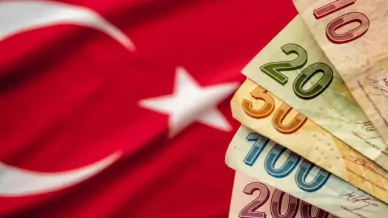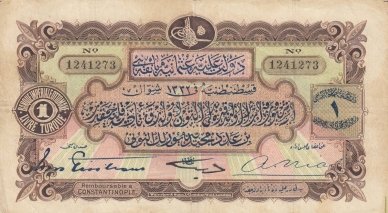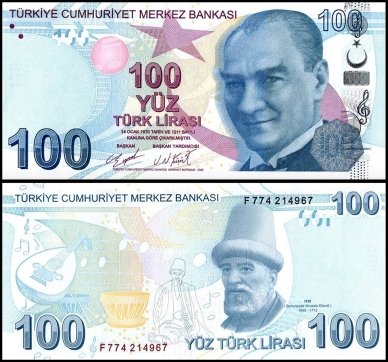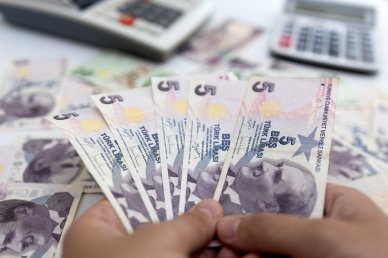The Turkish Lira

The Turkish lira (TRY, türk lirası, ₺) is the official currency of Turkey. It is also used as the means of payment in Northern Cyprus - a part of an island that belongs to Turkey.
It is not a stable currency, and its exchange rate is very dependent on the general financial tendencies in the world.

History
The lira appeared in the 1920s when President Atatürk abolished the Ottoman lira - a predecessor of the current Turkish currency. The Ottoman lira began its circulation in the middle of the 19th century and substituted akçe and kuruş - the money that circulated on the territory of the Empire for several centuries.

The Ottoman lira (1914)
At first, it used to be golden but internal political and economic problems of the decaying Empire devalued the new currency very fast. By the time the Ottoman Empire dissolved in 1923, the lira had almost lost its provision. But it continued its circulation along with the new money.
In the 1930s, there were several attempts to peg the exchange rate of the Turkish lira to more stable currencies like the British pound, and later - to the French franc. However, both attempts were unsuccessful because of their devaluation.
In 1935, the lira was pegged to the US dollar, and the peg remained till 1980. However, in the same year, its exchange rate in relation to USD had a record drop from 2.8:1 to 9:1. The reason was that in 1947 Turkey joined the IMF, and thus the new obligations were imposed on the country. To fulfill them, the Turkish lira exchange rate had to be artificially strengthened. As a result, a devastating devaluation took place.
TRY is the world record holder in devaluation. In 2001, the Central Bank issued the banknote in the denomination of ₺20 million. Thus, the exchange rate to the USD dropped to 1,68,000,000:1.
In 2005, the Turkish government redenominated the national currency: a new lira equaled 1 million old liras. The transition period lasted from 2005 to 2008. During that time, the coins in denominations from 1 kuruş to 50 kuruş, 1 new lira, and the banknotes in denominations of 5, 10, 20, 50, 100, and 200 new liras appeared. That design and official name ‘new’ (‘yeni’) operated till 2009 when new money became legal tender.
Since 2009, all paper money including both ‘yeni’ and the current one has been in circulation. In 2012, there was a country-wide contest held to create a unique currency sign of the Turkish lira. Four contenders reached the final round but the winner was Tülay Lale. Her design featured a Latin letter L with a double stroke.
Design
The reverse sides of all coins and obverse sides of all banknotes feature the first president of the republic - Kemal Atatürk. Even a hundred years after his death, he has remained the national leader of the Turks.
There is only one portrait of Mustafa Kemal Atatürk used, but its angles on the banknotes change depending on a denomination. For instance, a ₺5 banknote features the full-face President’s portrait, and a ₺200 banknote depicts his face in profile.
The coins of the 2009 mint series in denominations of 1, 5, 10, 25, and 50 kuruş and ₺1, and the banknotes in denominations of ₺5, ₺10, ₺20, ₺50, ₺100, ₺200 are in current circulation. The coins of 1-25 kuruş are made of a homogeneous alloy of copper, nickel, and zinc. The 50 kuruş coins and ₺1 are of a bimetal composition: the ring is made of white alloy and the centre contains the metal of yellow colour.

₺100 banknote
The banknotes depict President Atatürk on the obverse and other prominent Turks who greatly contributed to the development of Turkish science, culture, and technology:
- ₺5 is a brown banknote that measures 130 mm by 64 mm. The reverse side features the portrait of Aydın Sayılı, a Turkish historian of science, in the background of the Solar system fragments, atom, and DNA.
- ₺10 is a red banknote that measures 136 mm by 64 mm. On the reverse, there is the portrait of Cahit Arf, a Turkish professor of mathematics, in the background of the Arf invariant.
- ₺20 is a green banknote that measures 142 mm by 68 mm and features the image of Mimar Kemalettin, a Turkish architect, in the background of the Gazi University main building on the reverse. There are also a cube, a globe, and a cylinder.
- ₺50 is an orange banknote that measures 148 mm by 68 mm and depicts the portrait of Fatma Topuz, a Turkish writer, in the background of writing essentials.
- ₺100 is a blue banknote that measures 154 mm by 72 mm. On the reverse side, there is a portrait of Buhurizade Mustafa Itri, a Turkish musician, and a Persian poet Rumi in the background of music symbols.
- ₺200 is a violet banknote that measures 160 mm by 72 mm and features a Turkish poet Yunus Emre in the background of his mausoleum, birds, and roses.
The Turkish Lira in the World

Turkish Lira banknotes
Türk lirası is one of the most unstable and cheapest currencies in the world. It is strongly dependent on the prices of gold, oil, and the general tendencies within financial markets. The lira has a fluctuating exchange rate controlled by the national government.
FAQ
When did the Turkish Lira appear?
The Turkish Lira (₺) appeared in 1923.
What was the Turkish currency before lira?
The Turkish currency before the lira was the Ottoman lira.
What is the name of Turkish lira?
The official name of the Turkish currency is "Türk Lirası," which is usually abbreviated as "TRY." The currency symbol for the Turkish lira is "₺."
The abbreviation TRY is used internationally to denote the Turkish lira, and it is commonly used in currency exchange rates and financial transactions. The symbol ₺ is used to represent the currency in both digital and written formats, making it easily recognizable and distinct in the world of global currencies.
What are the different types of Turkish lira?
The Turkish lira (TRY) consists of various banknotes and coins. Banknotes are issued in denominations of 5, 10, 20, 50, 100, and 200 lira. Coins come in 1, 5, 10, 25, 50 kuruş, and 1 lira. These different denominations facilitate daily transactions in Turkey.
Who is depicted on Turkish Lira banknotes?
Turkish Lira banknotes feature depictions of notable figures in Turkish history and culture. Some of the individuals portrayed on these banknotes include Mustafa Kemal Atatürk (the founder of the Republic of Turkey), Rumi (a renowned poet and philosopher), Fatma Aliye Topuz (a pioneering Turkish writer), and many others. The individuals chosen for the banknotes represent various aspects of Turkey's rich cultural and historical heritage.
Is the Turkish Lira a stable currency?
The stability of the Turkish Lira can vary over time due to economic factors.







